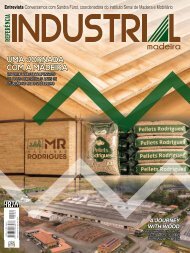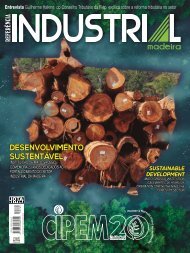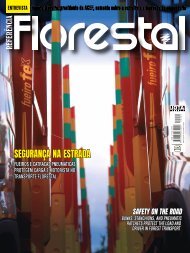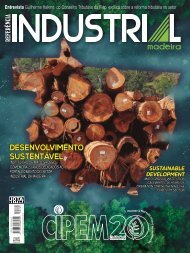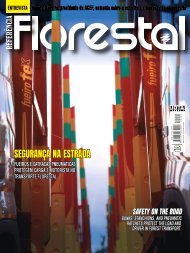Create successful ePaper yourself
Turn your PDF publications into a flip-book with our unique Google optimized e-Paper software.
As pesquisas precisam de<br />
um incentivo crescente para<br />
atender às demandas de um<br />
setor em crescimento<br />
>> Nos últimos anos, foi desenvolvido pelo governo federal o<br />
Pndfp (Plano Nacional de Desenvolvimento de Florestas Plantadas),<br />
com o objetivo de aumentar em 2 milhões de hectares a<br />
área de cultivos comerciais. Como isso impacta o setor florestal<br />
no país?<br />
Com a atividade florestal ocupando aproximadamente 1% do<br />
território nacional, o Brasil lidera o ranking mundial de produtividade<br />
florestal, possuindo 7,83 milhões de hectares plantados e<br />
sendo responsável por cerca de 6,9% do PIB Industrial nacional.<br />
O Pndfp incentiva que a atividade florestal de ponta, desenvolvida<br />
em nosso país, possa avançar e conquistar lugares de ainda<br />
mais destaque no cenário nacional e internacional, já que o setor<br />
é responsável por aproximadamente 10% da exportação relacionada<br />
ao agronegócio brasileiro.<br />
>> Como a sustentabilidade pode ser fortalecida a partir deste<br />
Plano Nacional?<br />
Em sua grande maioria, o setor florestal brasileiro está atendendo<br />
todas as diretrizes legais ambientalmente impostas, inclusive<br />
passando por processos de certificação internacional, obrigando<br />
o setor a se enquadrar entre os que mais protegem áreas naturais,<br />
representando em torno de 6 milhões de hectares destinados<br />
à conservação. O crescimento do setor deve estar atrelado<br />
também à capacidade de utilização da oferta de florestas no<br />
mercado, sendo que o Pndfp prevê incentivo ao beneficiamento<br />
desta madeira, promovendo a utilização do potencial produtivo<br />
de bens e serviços econômicos das florestas plantadas, como<br />
parte integrante da política de desenvolvimento. Verifica-se que<br />
o setor já está atento para este crescimento, realizando investimentos<br />
de médio e longo prazo para utilizar o potencial florestal<br />
das regiões de forma cada vez mais eficiente.<br />
>> Na sua visão, ainda falta incentivo governamental para a<br />
área de pesquisas florestais?<br />
O Brasil desenvolve tecnologia de ponta no setor florestal, sendo<br />
que as universidades e a Embrapa desempenham um papel fundamental<br />
no crescimento do setor de pesquisas. Entretanto, verifica-se<br />
que as pesquisas precisam de um incentivo crescente para<br />
atender às demandas de um setor em crescimento. Algumas<br />
necessidades, como a pesquisa que prevê o controle dos danos<br />
realizados pelos macacos-prego nos plantios de pinus é apenas<br />
uma das inúmeras pesquisas que precisam de mais incentivos<br />
Over the last few years, the National Plan for the Development<br />
of Planted Forests (Pndfp) has been elaborated by the<br />
Federal government, with the aim of increasing<br />
The Country leads the world ranking in forest productivity,<br />
with the forest activity occupying approximately 1% of<br />
Brazilian territory, having 7.83 million hectares planted, and<br />
accounting for about 6.9% of GDP the area of commercial<br />
crops by 2 million hectares. How does this impact the Forestry<br />
Sector in Brazil?. The Pndfp provides incentives so that the<br />
cutting-edge forest activity developed in our Country can advance<br />
and conquer even more prominence in the national and<br />
international scenario, since the Sector is responsible for approximately<br />
10% of exports related to Brazilian agribusiness.<br />
How is sustainability strengthened from this National Plan?<br />
The vast majority of the Brazilian Forestry Sector meets all<br />
environmentally imposed legal guidelines, as well as those<br />
included in the international certification processes, leading<br />
the Sector to be among those that most protect natural areas,<br />
representing around 6 million hectares destined for conservation.<br />
The growth of the Sector is also linked to the capacity to<br />
use the timber supply in the market, and as an integral part<br />
of development policy, the Pndfp provides incentives to the<br />
processing of this timber, promoting the use of the productive<br />
potential of the economic goods and services from planted<br />
forests. It can be seen that the Sector is attentive to this<br />
growth, making medium and long-term investments to use<br />
the forest potential of all regions in an increasingly efficient<br />
way.<br />
In your view, is there still a lack of government incentives for<br />
research in the forest area?<br />
Brazil has developed a state-of-the-art technology in the Forestry<br />
Sector, and universities and Embrapa have played a vital<br />
role in the growth of the research sector. However, research is<br />
needed to provide more incentives to meet the demands of a<br />
growing sector. Some needs, such as research that provides<br />
for the control of the damage done by capuchin monkeys in<br />
pine plantations, is just one of numerous studies that need<br />
more incentives to achieve results that can adapt to the environmental<br />
issues and reduce the economic damage caused to<br />
planted forests.<br />
Over the last few decades, Forestry has surpassed Extractivism<br />
in the participation of primary forest production in Brazil.<br />
In your opinion, what are the reasons for this movement?<br />
Currently, in Brazil, planted trees account for about 91% of all<br />
timber produced for industrial purposes in the Country, and<br />
the remaining 9% comes from legally managed natural forests.<br />
The use of native species ends up being very expensive,<br />
since one does not have control of the forest, as in a planted<br />
forest. Tree alignment, planting of homogeneous species,<br />
and at the same time, among other characteristics, which<br />
allow for a predictable production and planting management<br />
operations, lead to Forestry being much more commercially<br />
attractive, not to mention that the increased environmental<br />
bureaucracy created to prevent illegal deforestation ends<br />
Abril <strong>2020</strong><br />
31



